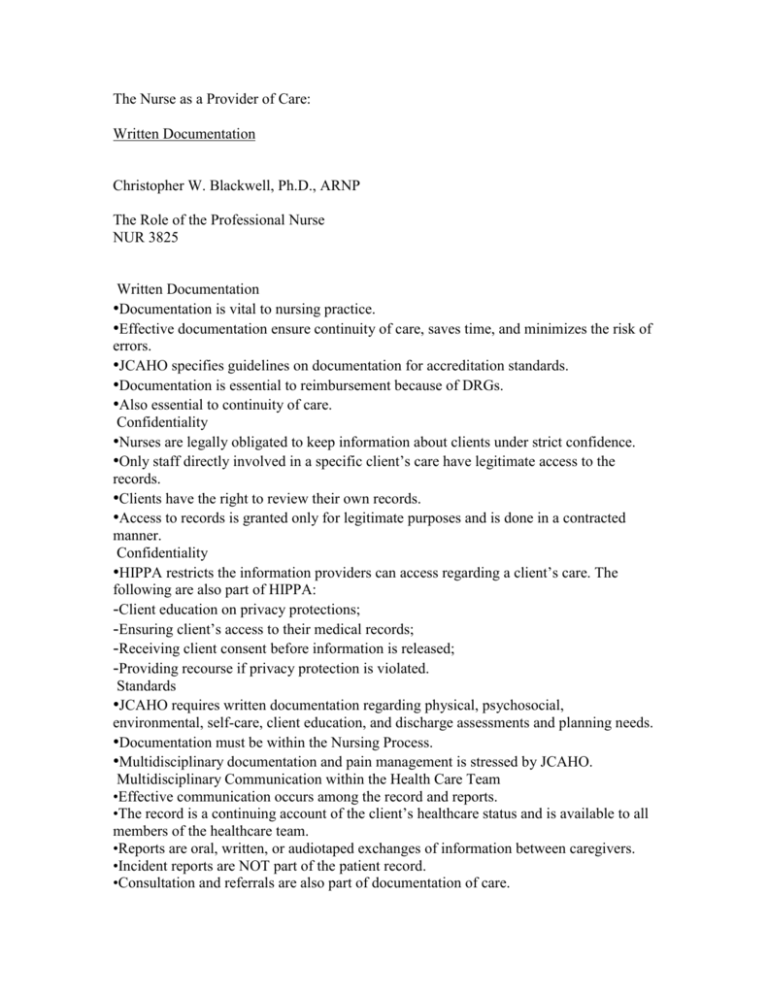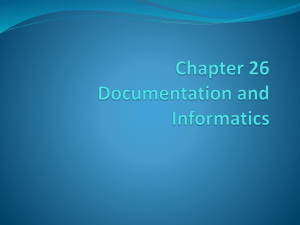The Nurse as a Provider of Care - Christopher W. Blackwell, Ph.D
advertisement

The Nurse as a Provider of Care: Written Documentation Christopher W. Blackwell, Ph.D., ARNP The Role of the Professional Nurse NUR 3825 Written Documentation •Documentation is vital to nursing practice. •Effective documentation ensure continuity of care, saves time, and minimizes the risk of errors. •JCAHO specifies guidelines on documentation for accreditation standards. •Documentation is essential to reimbursement because of DRGs. •Also essential to continuity of care. Confidentiality •Nurses are legally obligated to keep information about clients under strict confidence. •Only staff directly involved in a specific client’s care have legitimate access to the records. •Clients have the right to review their own records. •Access to records is granted only for legitimate purposes and is done in a contracted manner. Confidentiality •HIPPA restricts the information providers can access regarding a client’s care. The following are also part of HIPPA: -Client education on privacy protections; -Ensuring client’s access to their medical records; -Receiving client consent before information is released; -Providing recourse if privacy protection is violated. Standards •JCAHO requires written documentation regarding physical, psychosocial, environmental, self-care, client education, and discharge assessments and planning needs. •Documentation must be within the Nursing Process. •Multidisciplinary documentation and pain management is stressed by JCAHO. Multidisciplinary Communication within the Health Care Team •Effective communication occurs among the record and reports. •The record is a continuing account of the client’s healthcare status and is available to all members of the healthcare team. •Reports are oral, written, or audiotaped exchanges of information between caregivers. •Incident reports are NOT part of the patient record. •Consultation and referrals are also part of documentation of care. Purposes of Records •Communication: -The plan of care should be clear to anyone reading the chart. -A detailed nursing history and physical exam is essential for every admission. -Medical progress notes should compliment nursing process information. •Legal Documentation: -Accurate documentation is one of the best defenses for legal claims associated with nursing care. -Chart care immediately after provided. Purpose of Records •Financial Billing: -DRGs are often obtained from nursing documentation and establish a prospective payment system. •Education: -Students learn from documented care and draw conclusions about nursing care and interventions. •Research: -Statistics and process-related data is obtained from records. Purpose of Records • Auditing-Monitoring: - Nurses monitor or review records throughout the year to determine the degree to which quality improvement standards are met. Guidelines for Quality Documentation and Reporting •Factual: -A record must contain descriptive, objective information about what a nurse sees, hears, feels, and smells. Appears, seems, or apparent not appropriate. USE QUOTES!!! •Accurate: -Provide exact measurements without value. -Watch abbreviations. Entries require a signature. Guidelines for Quality Documentation and Reporting •Complete: -Documentation must include interventions and client responses to interventions. •Current: -Records are kept close to clients; military time is used (subtract 12 after 12). •Organized: -Practice documentation when needed and think before writing. Methods of Recording •Narrative Documentation: -Story-like descriptions of client status. •Problem-Oriented Medical Record (POMR): -Places emphasis on a client’s problems. -Database: Contains all available assessment data; -Problem List: Includes the client’s physiological, psychosocial, cultural, spiritual, developmental, and environmental needs. Methods of Recording •Problem-Oriented Medical Record (POMR): -Nursing Care Plan: developed for each problem by the disciplines involved in the client’s care. -Progress Notes: SOAP and SOAPIE Formats; PIE in POMR formats (without assessment data). Focus charting is more positive than strict POMR. Methods of Recording •Source Records: -Each discipline records in a specific area of the chart. -This can result in fragmentation of charting as each discipline addresses care differently. •Charting by Exception (CBE): -This format uses documents created with specific standards of care and addresses abnormalities. Methods of Recording •Case Management Plan and Critical Pathways: -Critical pathways are multidisciplinary care plans that include client problems, key interventions, and expected outcomes within an established time frame. -Critical pathways promote integration of information so that each discipline has access to notes written by others. -Variances from the critical pathway are documented and addressed. Common Record-Keeping Forms • Admission Nursing History Forms: - Establishes baseline data used to gauge changes in client’s condition. • Flow Sheets and Graphic Records: - Allows quick entry of VS, routine repetitive care, such as hygiene measures, ambulation, meals, weights, and safety and restraint checks. Common Record-Keeping Forms •Client Care Summary or Kardex: -Often computerized; provides a summary of all care provided during the shift. -Can be but not necessarily permanent parts of the client’s record. -Includes data about the care provided and what immediate care needs to be performed along with other pertinent data about the client’s care. Common Record-Keeping Forms •Acuity Records: -Determine appropriate size of staff needed on a unit based on amount of care clients need. •Standardized Care Plans: -Care plans established based on standards of care; patient-specific modifications are made in ink. -Standardized plans do not replace individual approaches to nursing care. Common Record-Keeping Forms • Discharge (DC) Summary Forms: - Multidisciplinary approaches in discharge planning is best to help link clients with resources and discharge in a timely manner. - Discharge should begin at admission. - DC paperwork must address a plethora of criteria through JCAHO. Home Care Documentation • Documentation in the home must include all services provided in a comprehensive manner– many times, the home health RN is the only health team member contact with the client and client’s family. Long-Term Health Care Documentation •Clients Residents •Governmental agencies help establish documentation standards in long-term facilities. •The overall goal of is a system of clinical documentation that provides improved care for residents and increased reimbursement for that care. •State Departments of Health define frequency of documentation. Computerized Documentation •Increasingly, software programs allow nurses to quickly specific assessment data, fill in forms with typical entry choices, allow narrative for unique situations, have adequate computer memory for large amounts of data, and automatically transfer information to different reports. •Computers also help generate nursing care plans and document all facets of client care. •Incorrect data is NOT deleted—they are corrected and accounted for. Reporting •Change-of-Shift Reports: -The purpose is to provide continuity of care among nurses caring for a client. -Can be oral, written, or even videotaped. -Oral reports allow for more question-answers and are possibly optimal. -Data conveyed need to be objective, current, and concise. -Page 496 has a good example of this. Reporting •Telephone Reports: -The nurse includes when the call was made, who made it, who was called, to whom information was given, what information was given, and what information was received. •Telephone or Verbal Orders: -Telephone and verbal orders must be clarified. -A 2nd RN is sometimes necessary to listen. Reporting • Transfer Reports: - Must include: Clients name, age, physician, and Dx ; Summary of progress up to time of transfer; current health status; allergies; code status; family support. Current Nursing Dx or problem and care plan; critical assessments and treatments; need for any special equipment needed. Reporting • Incident Reports: - These can be part of a unit’s quality improvement program. - They are NEVER part of the client record. - Are completed with ANY variance in client care.






